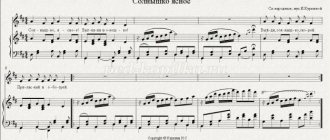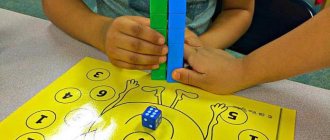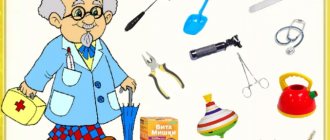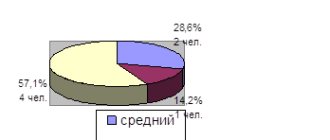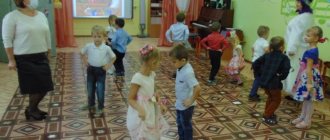Gaming technologies in music classes at preschool educational institutions
Gaming technologies in music classes at preschool educational institutions
Play is the main activity of a child. This is a free and independent activity that arises on the initiative of the child. The whole personality of the child is involved in the game process: cognitive processes, will, feelings, emotions, needs, interests. As a result, amazing changes occur in this personality. A game is a very specific type of activity, which has all the characteristics of an activity, but all of them are special.
Every activity has a purpose. What is the goal of the game? In fact, the game has a goal, not obvious, but no less significant than the goal of any other activity. This is the child’s awareness of himself as involved in the world of adults, transference into “adult” life.
What is the content of gaming activity? The game is, as it were, given by nature itself, so that the child prepares for adult life.
When we talk about activity, we also talk about its process. If in any other non-game activity the goal, the result, is important first of all, then in a game it is mainly the process that is important, since the game does not seem to have a visible goal. It is the interest in the game process itself that is the driving force that allows the game to last.
Any activity can take place as an amateur activity. The game is always an amateur activity. For example, you can work with both joyful feelings and hostility. Playing without having fun is impossible. The game is always joyful for those who play. If negative emotions arise in the game, then it stops and falls apart.
As already mentioned, a game is a type of activity whose motive lies not in the results, but in the process itself. For a child, play is a means of self-realization and self-expression. She allows him to go beyond the limited world of the nursery and build his own world. The game provides the child with emotional well-being, allows him to realize a variety of aspirations and desires and, above all, the desire to act like adults, the desire to control objects.
The game develops the ability to imagine and think creatively.
In the game, the child also gains experience of voluntary behavior, learns to control himself, observing the rules of the game.
Let us turn to the game as a pedagogical category. Since play occupies a huge place in development, it has long been used as a pedagogical tool.
Play in the pedagogical process can “merge” with other types of activities, enriching them. For example, it is well known that the merging of work and play activities in childhood has a positive effect. In addition, didactic games occupy a special place in pedagogy, significantly enriching the learning process.
What tasks can gaming activities help a teacher accomplish? First of all, it is establishing contact with the child. Speaking about this method of establishing contact, teachers call it contact of community, co-creation, the best way to enter into a trusting, friendly relationship with a child.
The game is also an excellent diagnostic tool for both individuals and groups. In addition to the personal development of the child, the game allows you to establish what the child strives for and needs, since in the game he strives to take the desired role. If a child does not want to do any work, if he is not interested in learning, then the game can come to the rescue, because it is a powerful stimulant.
The concept of “game pedagogical technologies”
includes a fairly extensive group of methods and techniques for organizing the pedagogical process in the form of various pedagogical games.
Unlike games in general, a pedagogical game has an essential feature - a clearly defined learning goal and a corresponding pedagogical result.
The game form of classes is created by game motivation, which acts as a means of inducing and stimulating children to educational activities.
The implementation of gaming techniques and situations in the classroom takes place in the following main areas:
- a didactic goal is set for children in the form of a game task;
- educational activities are subject to the rules of the game;
- educational material is used as its means;
- an element of competition is introduced into educational activities, which transforms a didactic task into a game one;
- successful completion of a didactic task is associated with the game result.
The place and role of gaming technology in the educational process, the combination of game and learning elements largely depend on the teacher’s understanding of the functions and classification of pedagogical games.
Based on the nature of the pedagogical process, the following groups are distinguished:
- teaching, training, controlling and generalizing;
- cognitive, educational, developmental;
- reproductive, productive, creative;
- communicative, diagnostic, psychotechnical, etc.
The specifics of gaming technology are largely determined by the gaming environment: there are games with and without objects, board-print games; indoor, outdoor, on the ground, computer, as well as with various means of transportation.
Game functions.
Game is a complex and multifaceted phenomenon. The following functions can be distinguished:
Communication function
– uniting children and adults, establishing emotional contacts, developing communication skills.
Relaxation function –
relieving emotional (physical) stress caused by the load on the child’s nervous system during intensive study and work.
Compensatory function
– creating conditions for satisfying personal aspirations that are not feasible (difficult to achieve) in real life.
Psychotechnical function
– formation of skills to prepare one’s psychophysical state for more effective activities, restructuring of the psyche for intensive assimilation.
Educational function
– development of general educational skills such as memory, attention, perception and others.
Entertainment function
– creating a favorable atmosphere in the classroom, transforming a lesson and other forms of communication between an adult and a child from a boring event into an exciting adventure.
Self-expression function
– the child’s desire to realize his creative abilities in play and to more fully discover his potential.
Methodology for organizing didactic games.
The organization of didactic games by the teacher is carried out in three main directions: preparation for the didactic game, its conduct and analysis
Preparation for conducting a didactic game includes:
- selection of games in accordance with the objectives of education and training: deepening and generalizing knowledge, developing sensory abilities, activating mental processes (memory, attention, thinking, speech), etc.;
- establishing compliance of the selected game with the program requirements for the education and training of children of a certain age group;
- determining the number of players (the whole group, small subgroups, individually);
- preparation of the necessary did. material for the selected game (toys, various objects, pictures, etc.);
- preparation of the teacher himself for the game: he must study and comprehend the entire course of the game, his place in the game, methods of managing the game;
- preparing children for play: enriching them with knowledge, ideas about objects and phenomena of the surrounding life necessary to solve a game problem.
Conducting didactic games includes:
- familiarizing children with the content of the game, with did. material that will be used in the game (showing objects, pictures, a short conversation, during which children’s knowledge and ideas about them are clarified);
- explanation of the course and rules of the game;
- demonstration of game actions, during which the teacher teaches children to perform the action correctly;
- determining the role of the teacher in the game, his participation as a player, fan or referee. The degree of direct participation of the teacher in the game is determined by the age of the children, their level of training, and the complexity of the task. tasks, game rules;
- summing up the game is a crucial moment in its management, because Based on the results that children achieve in the game, one can judge its effectiveness and whether it will be used with interest in children’s independent play activities. When summing up the results, the teacher emphasizes that the path to victory is possible only through overcoming difficulties, attention and discipline.
At the end of the game, the teacher asks the children if they liked the game and promises that next time they can play a new game, it will be also interesting. Children usually wait for this day.
Analysis of the game
is aimed at identifying methods of its preparation and implementation: which methods were effective in achieving the goal, what did not work and why. This will help improve both the preparation and the process of playing the game, and avoid subsequent mistakes. In addition, the analysis will allow us to identify individual characteristics in the behavior and character of children and, therefore, correctly organize individual work with them. Self-critical analysis of the use of the game in accordance with the goal helps to vary the game and enrich it with new material in subsequent work.
Guide to didactic games.
Successful management of didactic games primarily involves selecting and thinking through their program content, clearly defining tasks, determining their place and role in the holistic educational process, and interaction with other games and forms of education. It should be aimed at developing and encouraging children’s cognitive activity, independence and initiative, their use of different ways to solve game problems, and should ensure friendly relations between participants and a willingness to help their comrades.
When playing with toys, objects, materials, small children should be able to knock, rearrange, rearrange them, disassemble them into their component parts (collapsible toys), put them back together, etc. But since they can repeat the same actions many times, the teacher needs to gradually change the game
The development of interest in didactic games and the formation of play activities in older children (4-6 years old) is achieved by the fact that the teacher sets increasingly more complex tasks for them and is in no hurry to suggest play actions. The play activity of preschoolers becomes more conscious; it is more aimed at achieving a result, and not at the process itself. But even for older preschoolers, the management of the game should be such that the children maintain an appropriate emotional mood, ease, so that they experience the joy of participating in it and a sense of satisfaction from solving the assigned tasks.
The teacher outlines a sequence of games that become more complex in content, didactic tasks, game actions and rules. Individual isolated games can be very interesting, but using them outside the system cannot achieve an overall educational and developmental result. Therefore, the interaction of learning in the classroom and in the didactic game should be clearly defined.
It should be taken into account that in a didactic game, the correct combination of clarity, the words of the teacher and the actions of the children themselves with toys, play aids, objects, etc. is necessary.
When directing games, the teacher uses a variety of means of influence on preschoolers. For example, acting as a participant in the game, he directs the game unnoticed by them, supports their initiative, and empathizes with them the joy of the game. Sometimes the teacher talks about an event, creates the appropriate gaming mood and maintains it during the game. He may not be involved in the game, but as a skillful and sensitive director, preserving and preserving its amateur character, he guides the development of game actions, the implementation of the rules and, unnoticed by the children, leads them to a certain result. When supporting and awakening children's activity, the teacher most often does this not directly, but indirectly: he expresses surprise, jokes, uses various kinds of playful surprises, etc.
We must remember, on the one hand, the danger of over-intensifying the teaching moments, weakening the beginning of the game, giving the didactic game the character of an activity, and, on the other hand, being carried away by the entertainment, escaping from the task of teaching.
The development of the game is largely determined by the pace of children’s mental activity, the greater or lesser success of performing game actions, the level of assimilation of the rules, their emotional experiences, and the degree of enthusiasm. During the period of assimilation of new content, new game actions, rules and the beginning of the game, its pace is naturally slower. Later, when the game unfolds and the children get carried away, its pace quickens. By the end of the game, the emotional upsurge seems to subside and the pace slows down again.
When finishing the game, the teacher should arouse children’s interest in continuing it and create a joyful prospect. Usually he says: “The new game will be even more interesting.” The teacher develops versions of games familiar to children and creates new ones that are useful and exciting.
Pedagogical value of didactic games.
In didactic games, children are given certain tasks, the solution of which requires concentration, attention, mental effort, the ability to comprehend the rules, sequence of actions, and overcome difficulties.
They promote the development of sensations and perceptions in preschoolers, the formation of ideas, and the acquisition of knowledge
These games make it possible to teach children a variety of economical and rational ways to solve certain mental and practical problems. It is necessary to ensure that didactic play is not only a form of assimilation of individual knowledge and skills, but also contributes to the overall development of the child and serves to shape his abilities.
The didactic game helps solve the problems of moral education and develop sociability in children. The teacher places children in conditions that require them to be able to play together, regulate their behavior, be fair and honest, compliant and demanding.
3. IMPLEMENTATION OF GAME TECHNOLOGY INTO PRACTICE.
In my classes I use the following types of didactic games:
- role-playing;
- movable;
- desktop
Each game has its own task aimed at perceiving various properties of sound.
Characteristic of each didactic game is the presence in it of:
- learning task;
- contents and rules;
- game actions.
I use the following types of musical and didactic games:
- for the development of pitch hearing;
- to develop a sense of rhythm;
- on the development of timbre hearing;
- for the development of memory and hearing;
- for the development of children's creativity.
I use musical teaching aids and games:
- in the process of singing;
- while listening to music;
- in the process of rhythmic movements;
- while playing children's musical instruments.
Gaming technologies in music classes at preschool educational institutions
Childhood is a special world that remains in a person’s soul for the rest of his life if happiness and joy of being oneself reign in it. The world of fantasy and fiction in children is associated with play
. In all historical times, children of different nations played and play, imitating adults, realizing their desires and creative abilities.
The most useful games for a child of senior preschool age are those that focus on the development of cognitive abilities, attention, memory, and thinking.
The development of a child depends on the conditions of upbringing and education in kindergarten and in the family. The task of teachers, musical
leaders and parents - to contribute in every possible way to the full development of children, and pedagogical
technologies
.
What is pedagogical (educational) technology ?
Under educational technology
refers to an ordered system of actions, the implementation of which leads to the guaranteed achievement of pedagogical goals.
Thus, technology
reflects the sequence of pedagogical activity, its logic and therefore is always represented by stages of activity, each of which has its own goal. Only after achieving the goal of one stage does the transition to the next stage of activity occur.
Moreover, the first stage of any technology is diagnostic
, and this is the distinctive feature
of technology
from traditional teaching methods.
To implement the technological
approach, detailed information about the initial state of each child is needed. The initial object of the teaching methodology is the “average” preschooler (a pupil whose initial state does not matter for constructing a methodological system.
Types of educational technologies
• “Health-saving”
technology
• “TRIZ” technology
• Problem-based learning technology
• Maria Montessori technology
.
• " Game "
, etc.
Game pedagogical technology
— organization of the pedagogical process in the form of various pedagogical games. This is the consistent activity of the teacher in:
• selection, development, preparation of games;
• inclusion of children in play activities
;
• implementation of the game itself;
• summing up the results of gaming activities
.
Pedagogical technology of music
education is a tool that allows
the music
director of a preschool educational institution to effectively solve the problems of his professional activity.
Unlike methods, methods and techniques, pedagogical technology allows musical
the manager should not only state:
“I know how
,” but also answer the question
“Why am I doing this
.
In addition, the use of pedagogical technologies
makes the process of solving problems consistent, orderly, thoughtful and conscious, allowing the teacher to achieve the planned result.
This is a very important point, since technology
is one of the characteristics of a teacher in the 21st century.
Gaming technologies in music classes
:
• technology
elementary music playing - use
technology T
.
E. Tyutyunnikova “Elementary music-making with preschoolers”
promotes the development of their creative abilities, natural
musicality
, creates conditions for broad orientation in
music
and the accumulation of a stock of
musical impressions
, and helps to successfully solve the problems of the preschool education program.
This technology
includes rhythmic games with various objects (game with sticks, game with spoons, game with buckets, with cups, with balloons, with balls, paper orchestra, etc.)
• Igrorhythmics
– is the basis for the development of a sense of rhythm and motor abilities of students, allowing them to freely, beautifully and correctly perform movements to
music
in accordance with its character, rhythm, and tempo.
This section includes special exercises for coordinating movements with music
,
musical tasks and games
.
Goal: to develop children's sense of rhythm and motor abilities. Teach children to perform movements to music beautifully
, freely, and with coordination.
• Game gymnastics
– serves as the basis for the child to master various types of movements, ensuring the effective formation of skills and abilities necessary when learning dance movements: to strengthen posture, to relax muscles, rhythmic exercises
( game massage , finger games)
• Technology
The practical development
of musical
information is based on the application of acquired knowledge, on the activation of auditory perception and imaginative
musical thinking
.
At the initial stage of learning, the child’s practical activity is manifested in various actions with rhythmic, sound or theoretical material. To organize such activities, visual aids are needed: cards, lotto, pictures, tables. Operating with auxiliary objects reinforces previously obtained sound images and theoretical information. The manifestation of student independence leads to the development of creative abilities. This technology includes
: listening to
music
, thinking about
music
, singing in chorus, games:
“guess the melody”
,
“what am I playing”
,
“What is music ”
, “
, etc. d.
• theater and gaming technology
.
Theatrical and gaming technology
has a special place in the work
of a music director
.
The main task of work in this direction is the development of theatrical abilities of preschool children through all types of musical activities
.
In working with children in preschool educational institutions, musical performances and musical
-rhythm games are of great importance. Development of a sense of rhythm, speech, singing breathing, coordination of movements, sense of orientation in space, expansion of the singing and speech range.
Songs - dramatizations, theatrical musical miniatures
,
musical
-rhythmic games and exercises, recitation to
music
.
Classification of songs for dramatization:
Folklore songs – round dances
Children's pop song
Singing songs
Songs - noisemakers.
Songs - dramatizations, such as “Two Cheerful Geese”
,
“Little Hedgehog”
,
“Antoshka”
and others, allow
children to develop creative abilities, communication skills, and emotions in children music classes
• dance - gaming technology
.
Igrodance
- a new term in the field of choreography.
Two words that are so clear and familiar to everyone. What is the main thing in the game? Someone will say that it is getting pleasure, someone will remember joy. What is the main thing in dance? Firstly - movement, secondly - rhythm, thirdly - music
.
That is, dance is a rhythmic movement to music
that brings joy, pleasure, and instills confidence in one’s abilities.
Igrodance includes
: dance
game songs
, mass dances, show dances (mirror dance, rhythm games, animated dances. Each
game dance
is aimed at developing a sense of rhythm, creating a special atmosphere, and the ability to quickly change roles.
In a music lesson
games are developmental in nature and are aimed at children mastering motor and intellectual skills, sensory abilities, developing cooperation skills, effective interaction based on cognitive interests.
In a music game
As in singing and rhythmic movements, children master the means of artistic expression characteristic of
music and speech - rhythm
, dynamics, tempo, pitch.
This gives the teacher the opportunity to differentially influence children with different rates of development. games with musical
accompaniment.
Music
helps to find the necessary motor pattern, gives plasticity and expressiveness to movements.
Through musical
play, children's abilities develop naturally and harmoniously.
The use of musical and gaming technologies will help the musical
the leader can conduct this or that section
of the lesson more entertainingly and effectively - singing
, listening, improvising.
Literature
1. Anisimova G. I. “100 musical games for the development of preschoolers”
, Yaroslavl
"Academy of Development"
2007.
2. Davydova M. A. “ Musical education in kindergarten”
,M.
"Waco"
2006.
3. Selevko G. K. “Modern educational technologies ”
, M. 2006.
4. Kasatkina E.I. Game in the life of a preschooler. - M., 2010.
5. Kasatkina E. I. Gaming technologies
in the educational process of preschool educational institutions. //Management of preschool educational institution. - 2012. - No. 5.
6. Karpyuk G. A. Realization of the child’s right to play. //Senior teacher. — 2007 — No. 6.
7. Penkova L. A., Konnova Z. P. Game
activity of preschoolers.
Shmakov S. A. “Student games - a cultural phenomenon”
, - M.: New School, 1999.
8. Shchurkova N. E. “Workshop on pedagogical technology ”
, M. 2001.
8
Gaming technologies for the musical development of preschool children
Zerdeeva Elena Yurievna, music director
Vasilyeva Tatyana Alekseevna, Deputy Head of SMR
MBDOU Kindergarten No. 1 “Mammoth”, Salekhard
GAME TECHNOLOGIES FOR MUSICAL DEVELOPMENT OF PRESCHOOL CHILDREN
There is a hidden bell in every person
and, if touched,
a person will sound with all
the best that he has.
M. Gorky
Sounds surround us everywhere and everywhere, they captivate us with their varied sounds, each of which can become music, you just need to try to hear it. Oh music! It has the potential to have a positive impact on very young children and gives positive emotions. And this is the internal well-being, mental and physical health of children.
The accumulation of musical experience in children is a pressing problem for the entire period of preschool childhood in general, and for each music director in particular. A child, starting from an early age, needs, first of all, to discover the world of sounds and music. One of the most exciting and entertaining forms of exploring the sound world is playing with sounds.
Game technology will help to implement all the ideas of sensory and musical education
!
Playful communication
in music classes has great creative potential, a wealth of emotional shades, unexpected turns of situations, and role changes. Children respond with pleasure to the opportunity for such communication.
Before starting the game process, it is necessary to introduce children to musical and noise (homemade) instruments, since they sound differently. For a more convenient distinction when working with them, kids should name them by appearance and characteristics, take into account what material they are made of (sound bags, bottles with cereal, etc.) It is important to acquaint children with the expressiveness of the sound of instruments and interest them.
The task of the music director is not only to organize the educational process, but also to sincerely rejoice at the children’s successes. In an unobtrusive introduction, invite children to look at this or that instrument, help the kids touch, pluck a string, and extract an unusual sound from it. Playing noise instruments and folk musical instruments, children are captivated by everything that is happening.
Exciting playing a musical instrument involves the use primarily of noise instruments, since these are the instruments that are simple and most accessible to young children. These include percussion instruments with an indefinite pitch: drums, cymbals, tambourine, triangle, castanets, etc.
When teaching young children to play musical instruments, it is necessary to observe consistency and regularity. In order to interest and teach a child to play noise instruments, we use the principle of concentricity: when initial knowledge and skills are layered with more and more new knowledge, gradually complicating tasks and exercises. When children have already accumulated their first auditory experience, it is necessary to show children the correct techniques for playing instruments, taking into account their age, level of development and abilities. Initially, the teacher often has to work individually so that children master the skill of playing instruments for joint play. When all the children hold the instruments well enough in their hands and know the basic ways of playing them, they can continue front work.
This type of noise toys involves teaching children not only the ability to produce sound at the right moment and monitor the dynamics of the sound, but also the ability to stop in time and maintain silence in order to hear the teacher’s explanations. Of course, for kids this is a particularly difficult task; to make the task of the music director easier, methods such as:
- the rattle is “sleeping” - children, holding the toy with one hand, put it on their laps and “cover” it with the other hand.
- bell - clamped in a fist
- chopsticks, spoons and rattles do not “touch” each other.
In order to organize the children of the newly recruited 1st junior group and create a working atmosphere (this includes initial acquaintance with the “noise makers” and the ability of children to fulfill the teacher’s requests, as well as a calm atmosphere in the classroom) it takes on average no more than two months with regular classes. Much less time is spent if children have previously systematically mastered the material.
Of course, the opportunities for children 2-3 years old are not so great and work needs to be carried out in subsequent age groups too. Teaching children to play noise instruments requires mutual understanding and contact between the music director and the students. Over time, children develop the ability to concentrate, be attentive, respond to the teacher’s signals: they started together, quietly - loudly, finished together, the toys calmed down, etc. etc. And in one or two years of training we manage to achieve positive results.
Of no small importance is the organization of classes, preliminary preparation, and the safety and security of children’s health. The safety of homemade tools cannot be neglected. Young children have a need to try everything to their teeth, so all “noisemakers” must comply with safety standards: no small parts, no screw caps (which give access to fillers, and these can be peas, buttons, beads, etc. ) and no stickers coming off. The exception is noisemaker toys, intended specifically for demonstration by the teacher. Typically, teacher tools are somewhat larger in size and have a complex and labor-intensive design method. It is necessary to exclude such instruments from the musical corner. There is no need to strive for a large number of options for “noise makers”; the main thing is that they differ from each other not only in appearance, but also in the way sound is extracted from them. During my work, I have acquired several of the most popular and easy-to-use tools:
1. “Bell” - a metal bell inside the neck of a small plastic bottle.
2. “Rustler” - a fabric bag (size 6 by 12 cm) filled with rustling cellophane.
3. “Gremelochka” - a plastic egg from Kinder Surprise, filled with peas. The rubber band goes through the egg. The length of the loop should be suitable for putting the toy on both the child’s hand and shoes.
4. “Bottle” - a bottle of Rastishka yogurt with a lid. Inside which there is loose cereal.
5. “Wooden sticks, wooden spoons.”
The number of instruments should preferably be equal to the number of children. When working with a tool, children should position themselves so that there is a good view, freedom of movement and quick access to the tools (toys do not fall to the floor).
To learn how to play noise instruments, you must follow the following steps:
- Introduction to the instrument (demonstration by the teacher): examination of the appearance, name, presence of a certain sound. Learning the rules of handling: how to hold it, what to do to make it sound, comparing it with a piece of music.
- Examining instruments, manipulating them, “testing” the sound. Scoring of simple games, use of two-part forms of works where no more than two types of sound extraction are used.
- Voice-over of “noisemakers” fairy tales, learning complex games, nursery rhymes with a large number of noise instruments accessible to children.
- Children's creativity in a noise orchestra.
When introducing children to noise instruments, it is possible to use any dance melody (“Polyanka”, “Oh you canopy”, “Like ours at the gate”...), where each part changes the method of voicing (knock on the bag, squeeze and unclench it, press on it with one finger and the whole palm, “wash” the movements...). We offer several examples of games with noise instruments.
| Game "Wash" | |
| Words | Actions |
| We took the bags in our hands | squeeze and unclench |
| Strong - washed tightly | “wash” the bag |
| We'll squeeze out the bags | squeeze out the bag |
| And then we'll start playing | slap the bag |
| Game "Winter" | |
| Words | Actions |
| Winter, winter - winter, | press with a finger |
| I swept away all the snowdrifts. | squeeze and unclench with your hand |
| We'll sit on the sled, hon. | roll between palms |
| And we'll roll into a snowdrift. | clap the bag with their whole palm |
Game "Bunny - Naughty"
On the table in front of the children are
noise instruments
.
The bunny be-ba-bo
says the words, then hides behind a screen and sounds with some kind of instrument.
The children are listening. They identify it by hearing and find the same one in themselves. At the end of the game, the bunny dances to the music, and the children play along on any instrument. Hello guys, here I am
I was in a hurry to see you, friends,
He fell head over heels from the hill.
I lost all my toys
And now there’s gibberish in the box,
Help me put it in place!
| Game with a “bottle” to the rhyme “Pie” | |
| Words | Actions |
| One two three four | knock on the palm |
| The dough was kneaded together. | thundering overhead |
| We rolled out a lump | roll between palms |
| And they made a pie. | transfer from one palm to another |
| They took him out of the oven, | set themselves |
| Cooled on a tray. | waving their hands at the bottle |
| Come here everyone | throw up their hands |
| We invite you, friends! | four claps overhead |
| Wooden sticks game | |
| Words | Actions |
| Tick-tock, tick-tock, the clock goes like this. | the sticks at the top are ticking left and right |
| Knock-knock, knock-knock, the wheels are knocking. | stick on stick |
| Knock-knock, knock-knock, our hammer knocks. | knocking with two sticks at the same time |
The younger age is valuable in that it allows the child to play music at his own request. In early preschool age, musical instruments are defined in their basic meaning, because playing noise instruments together is not primarily for play, but for communication.
Bibliography:
1. M. Trubnikova “Playing in an orchestra by ear” - Moscow, 2000.
2. L. Vinogradov “Music as the science of communication and imagination” “Kindergarten from all sides” No. 29, 2007.
3. T. Tyutyunnikova “Noise orchestra from the outside and from the inside” - “Musical Palette” No. 6, 2006.
Modern pedagogical technologies in the work of a kindergarten music director
Singing occupies a leading place in the system of musical and aesthetic education of preschool children. This type of activity also involves the use of new information technologies. Thus, the condition for good diction and expressive singing is to understand the meaning of the words and the musical image of the song, which is why we create electronic illustrations for various songs that require explanation of the text. The practice of working with preschool children in preschool educational institutions shows that the use of computer technologies contributes to the discovery, development and realization of the musical abilities of a preschool child.
The use of ICT when performing musical and rhythmic exercises and various dances helps children accurately follow the teacher’s instructions and perform movements expressively.
High-quality performance of dance compositions is facilitated by watching special video discs, for example, “Dance School for Children + Children's Multi-Disco” for children from 2 years old. The process of learning dances using educational video discs becomes fun and takes less time than with verbal explanations of dance movements and exercises. CDs for computers are widely used in the activities of music directors: Programs. Planning. Lesson notes. Music in preschool educational institutions.
Musical and didactic games are also conducted by the music director using colorful voiced presentations, such as “Guess the sound of a musical instrument”, “Who came to visit us? » “Musical House”, “Guess the Melody”, etc. The principle of constructing such presentations: the first slide is a task, the next is checking the correctness of the proposed task.
When teaching children to play musical instruments, the music director uses video recordings of concerts of a symphony orchestra, an orchestra of Russian folk instruments, and solo sounds of various instruments; will explain what an orchestra is, a group of instruments, and introduce the profession of a conductor. After watching the videos, children develop an interest in the coordinated performance of music on children's musical instruments and the correct sound production.
Videos make it interesting, bright and understandable for preschoolers with different types of art, such as theater, ballet, opera.
The practice of working with preschool children in preschool educational institutions shows that the use of computer technologies contributes to the discovery, development and realization of the musical abilities of a preschool child.
Using a computer in a preschool allows the music director to significantly enliven joint educational activities with children. Computer technologies expand the capabilities of a music director in presenting musical and didactic material provided for in the educational program of a preschool institution. It is very important that the music director, using ICT, has the additional opportunity to transmit visual information to children. Music classes using ICT enhance preschoolers’ cognitive interest in music and activate children’s attention, as new motives for mastering the proposed material appear. In such classes, children are more active in joint discussion of a piece of music. Musical lessons become more meaningful, harmonious and productive.
